Convection ovens: yay or nay?
March 28, 2022 by DarcieEvery high-end oven has a convection feature, and it is becoming increasingly popular on the mid-range models as well. But is convection something you really need? The Washington Post’s Aaron Hutchinson gives us a primer on this useful oven feature, explaining the hows, whens, and whys of convection.

At its most basic, the convection feature incorporates a fan that moves the heated air around the oven, creating a more even heat and adding a drying effect. The better models – known as true convection or European convection – also include a separate heating element at the back of the oven to make the fan even more effective. So how does this benefit our cooking?
Convection heat speeds up the cooking process, offering roast chickens in 25% less time, for example. It also makes it easier to bake multiple trays at one time because the temperature inside the oven cavity is more uniform from top to bottom and front to back. Convection does have its downsides, however. As many people pointed out in the comments, the fan can end up splattering fat on the sides of the oven, and if you use it for the wrong purpose it the drying effect can be harmful. Cakes can get overbaked on the top while still gooey in the middle, and delicate macarons can suffer from the same fate.
When I purchased my oven a few years back, I was eager to use the convection feature, but I have not used it nearly as much as I thought I would. For one thing, I can never remember which convection feature automatically adjusts the oven temperature and which one doesn’t (why didn’t they make it the same?). I also don’t bake multiple racks of food at once like I used to do.
Even though I do not use it frequently, I am still glad it is there when I need it – plus it seems to help the oven preheat more quickly. I won’t be going back to a regular oven, because I appreciate all of the benefits, such as getting extra crispy edges on my roast potatoes. After all, as Hutchinson points out in the article, an air fryer is just a small convection oven, so extra crispy food is one of the best things about this common feature.
Categories
- All Posts (6940)
- Antipasto (2135)
- Author Articles (247)
- Book News (935)
- Cookbook Giveaways (983)
- Cookbook Lovers (257)
- Cooking Tips (109)
- Culinary News (299)
- Food Biz People (552)
- Food Online (791)
- Holidays & Celebrations (272)
- New Cookbooks (149)
- Recipes (1500)
- Shelf Life With Susie (231)
- What's New on EYB (133)
Archives
Latest Comments
- kmwyman on Rooza by Nadiya Hussain – Cookbook Review and Giveaway
- Maryd8822 on The Golden Wok – Cookbook Giveaway
- Dendav on Danube Cookbook Review and Giveaway
- sanfrannative on Rooza by Nadiya Hussain – Cookbook Review and Giveaway
- darty on Danube Cookbook Review and Giveaway
- Atroyer7 on Danube Cookbook Review and Giveaway
- demomcook on What foods do you look forward to the most for each season?
- demomcook on Danube Cookbook Review and Giveaway
- Darcie on How cookbooks can help build resilience
- mholson3 on Danube Cookbook Review and Giveaway